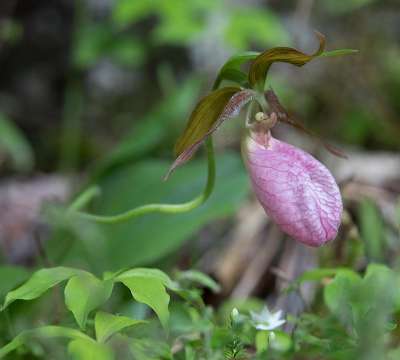We have a patch of about 100 pink moccasin lady’s slippers in our woods, and every year, some of the blossoms get munched. We assumed that deer were the culprits. There’s a deer yard up at the top of our woodlot, not far from the ledge where the lady’s slippers grow, and plenty of sign of deer browsing on hardwood saplings.
This spring, one of our lady’s slippers blossomed a week before the others. This was a perfect set up: because there was only one bloom available, there was a good chance of identifying the perpetrator. We attached a Moultrie A-20 camera to a tree and set it for video recording. What followed was a bit surprising.
Deer passed through and ignored the lady’s slipper, one even after nuzzling it and eating plants to the left and the right. And then there was this fellow. Although you don’t see the actual chomp, we were up at the site shortly after this video was taken, and the blossom was gone.
What’s curious is that bears came through the patch repeatedly afterwards without noticeable damage to the flowers. The yearling bear who chomped the season’s first bloom turned out to have a sibling and a mom roving around with him, but their only added crime was knocking down cameras from trees in a frequent but non-destructive way, and smearing lenses with bear snot.
We asked bear expert Ben Kilham for his perspective on the first flower’s fate, and he suggested that this might have been a case of curiosity, not consumption. In his own walks with orphaned cubs, he has seen young bears investigate different plants by mouthing them, and remembered a cub sampling a blossom and – seeming to enjoy its texture – making a “chuckling sound that expresses contentment.”
So, at least this year, the deer and the bears both appeared to be (mostly) innocent parties. There was a more destructive presence at work, however: a mysterious and spiteful decapitator. Something cut off blossoms at neat 30 degree angles, and then left both the shorn stem and blossom untouched. There appeared to be no purpose or pattern to this damage: single, slaughtered blossoms were spaced far apart across the patch. This made it difficult to anticipate where the decapitator would strike next. We tried to catch it in the act by placing game cameras at the base of tree trunks where there were wide, stem-height views of the patch, but all we got was bear snot.
A knowledgeable friend has since suggested that the decapitator might be some kind of cutworm. We’ll have to investigate this idea next year.


